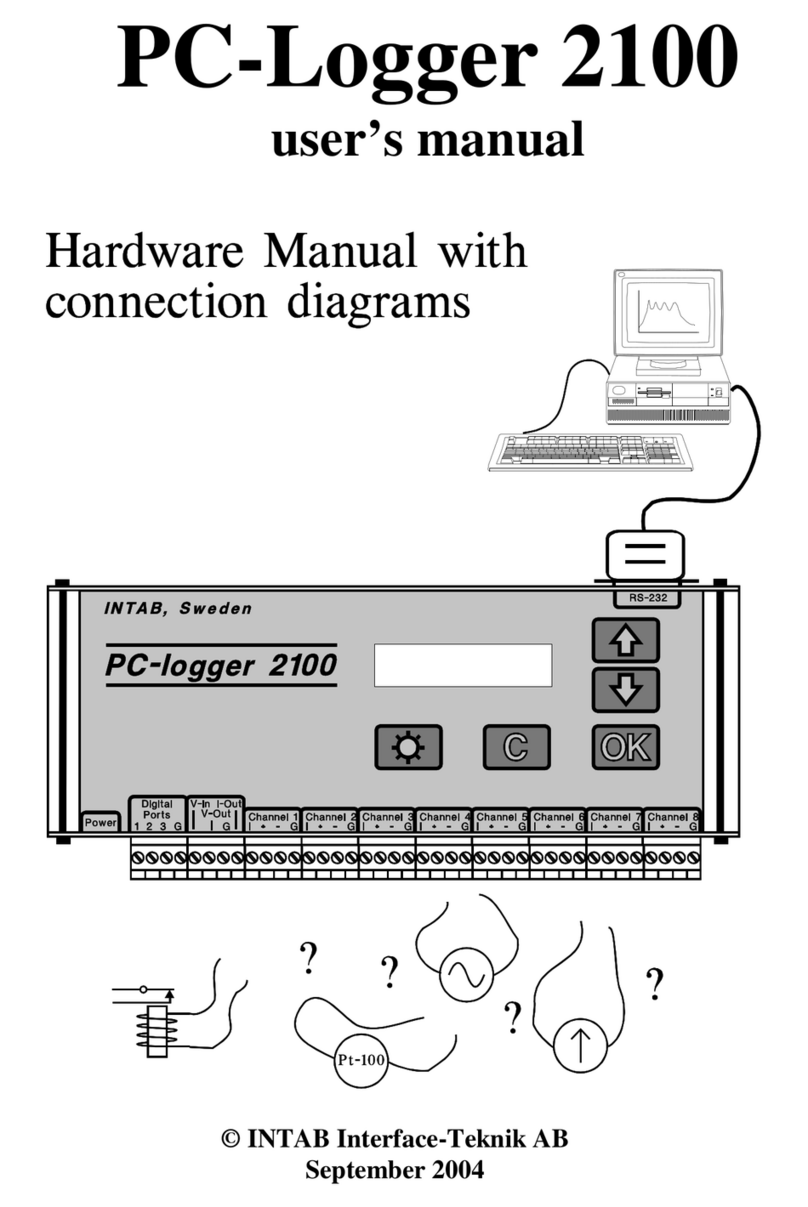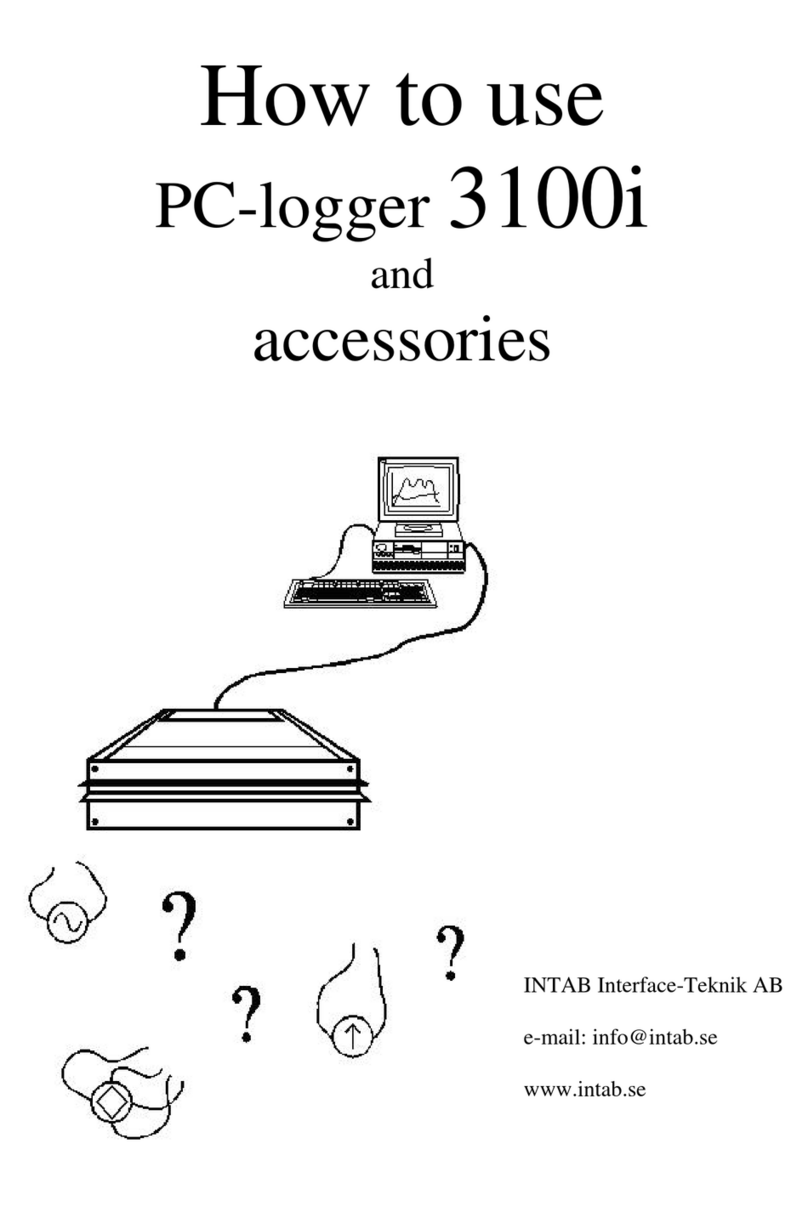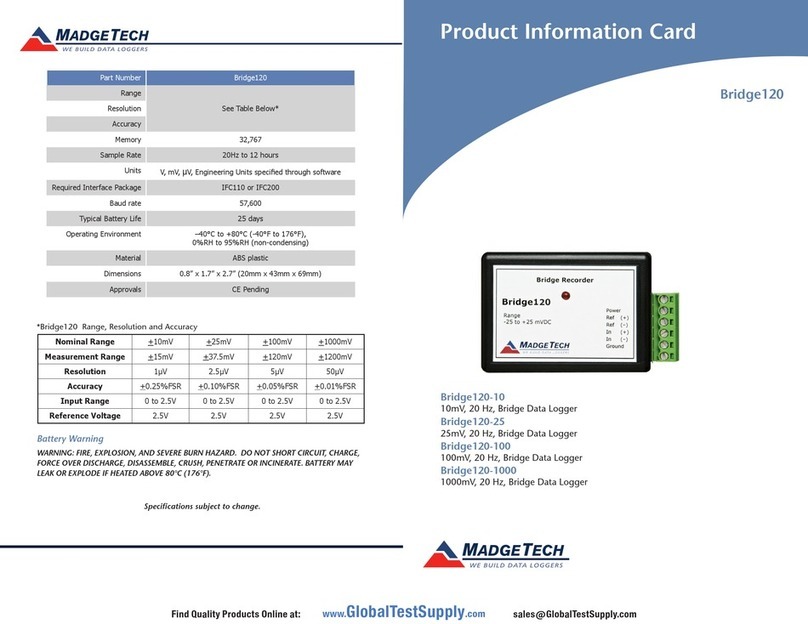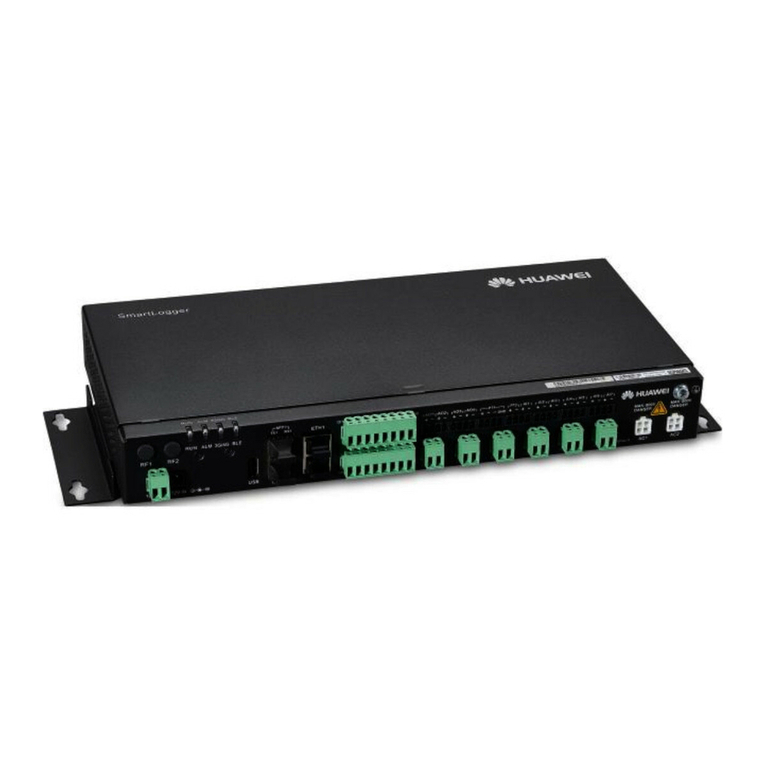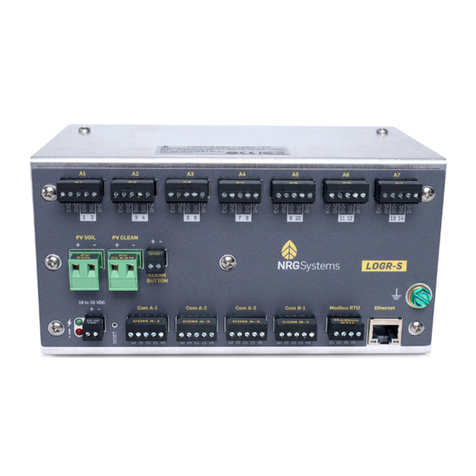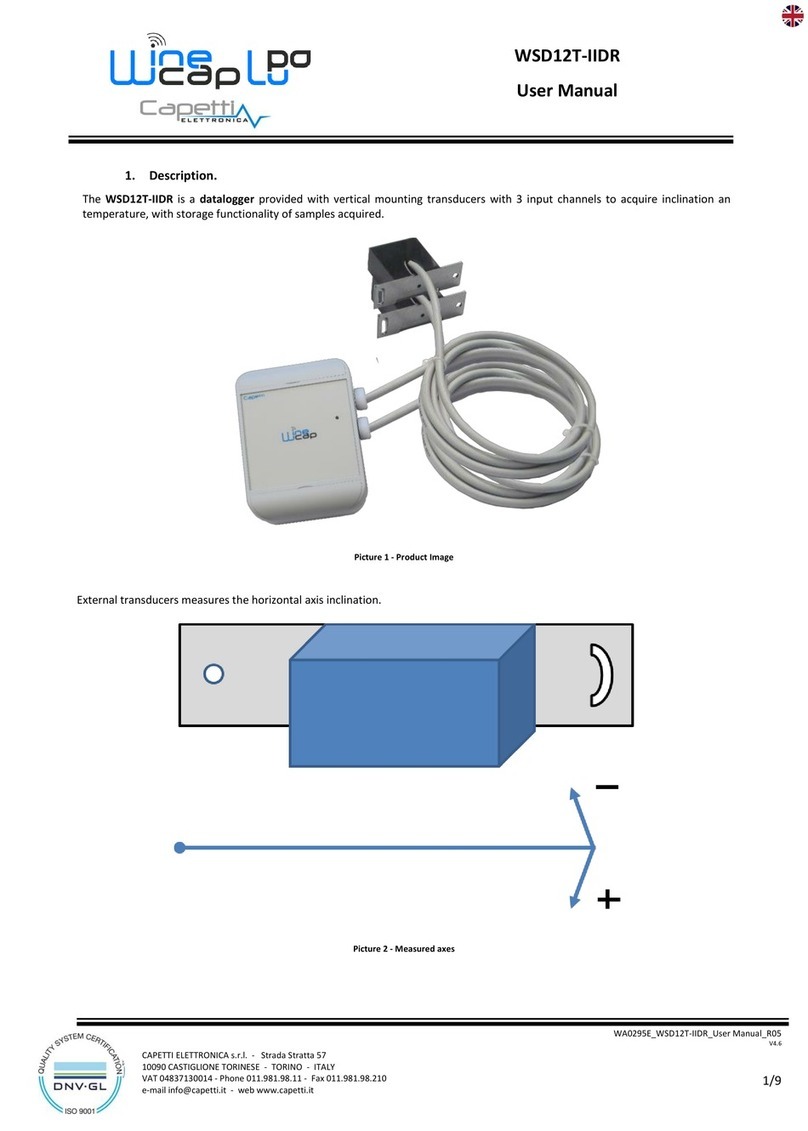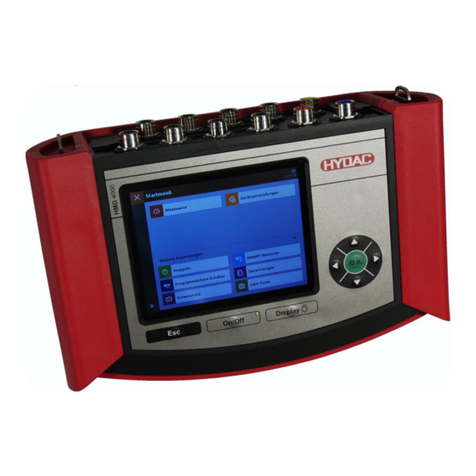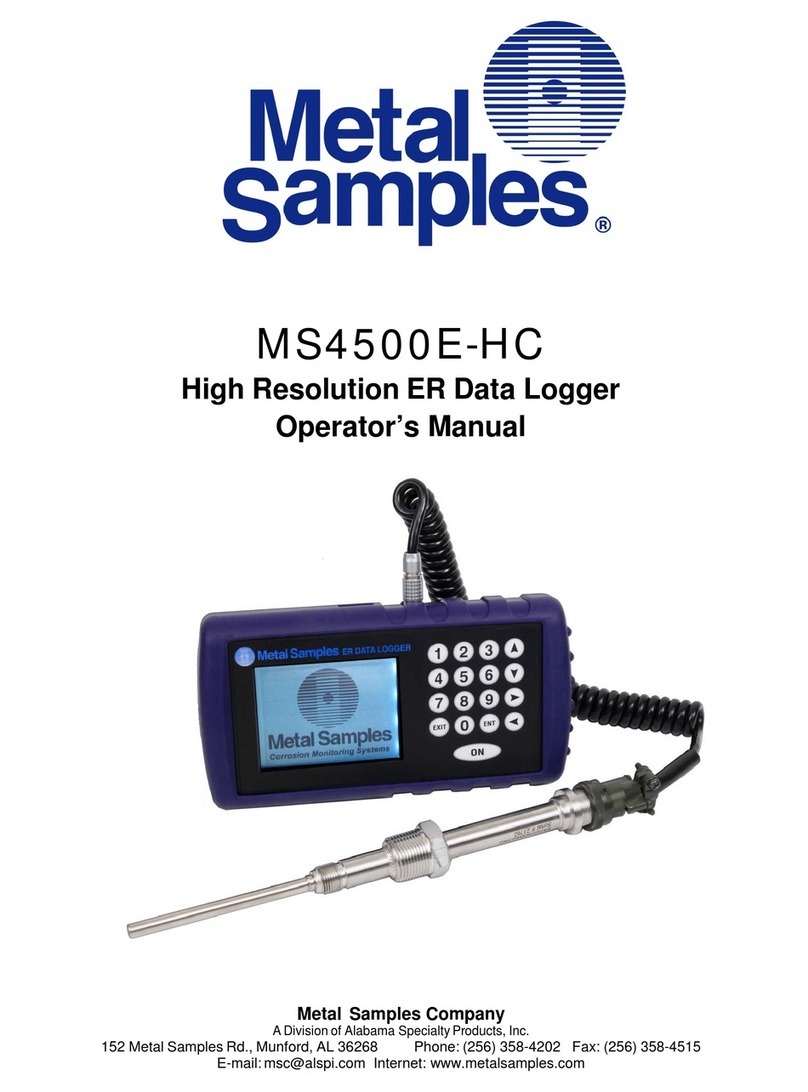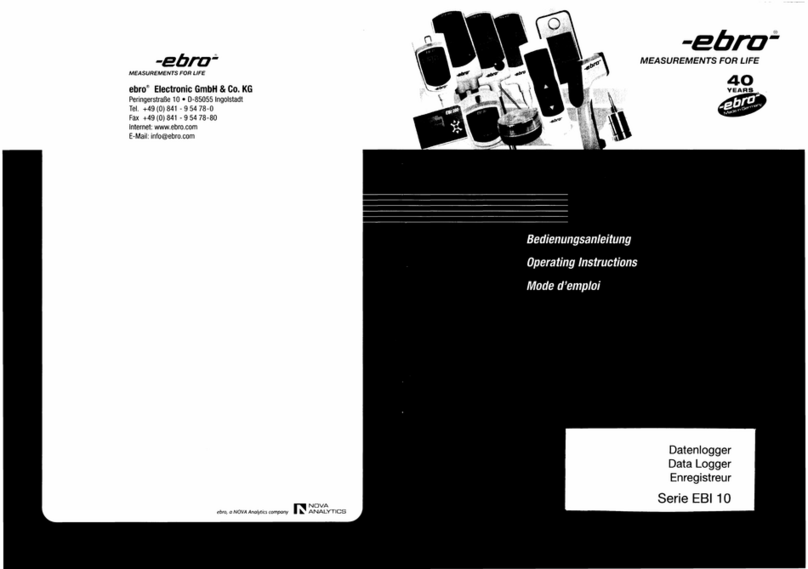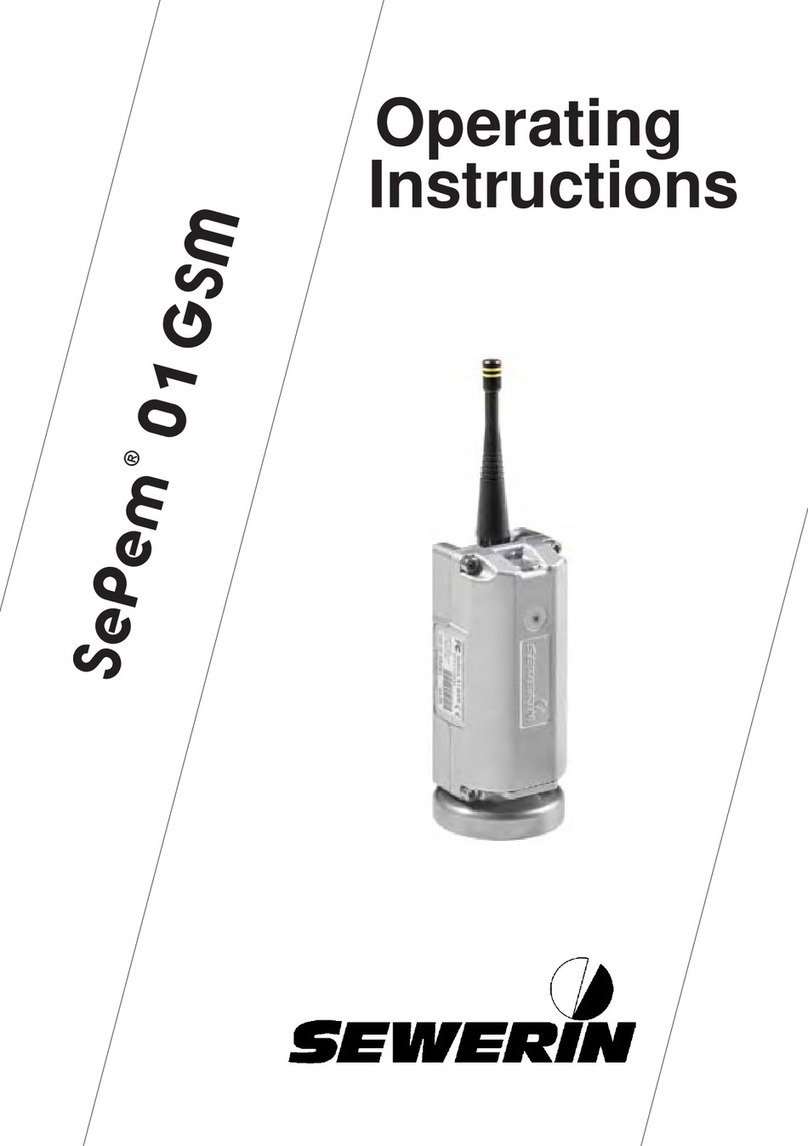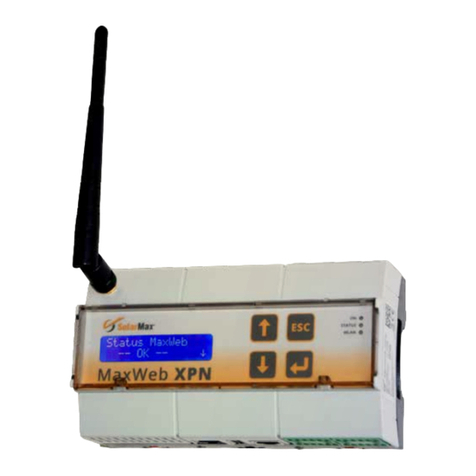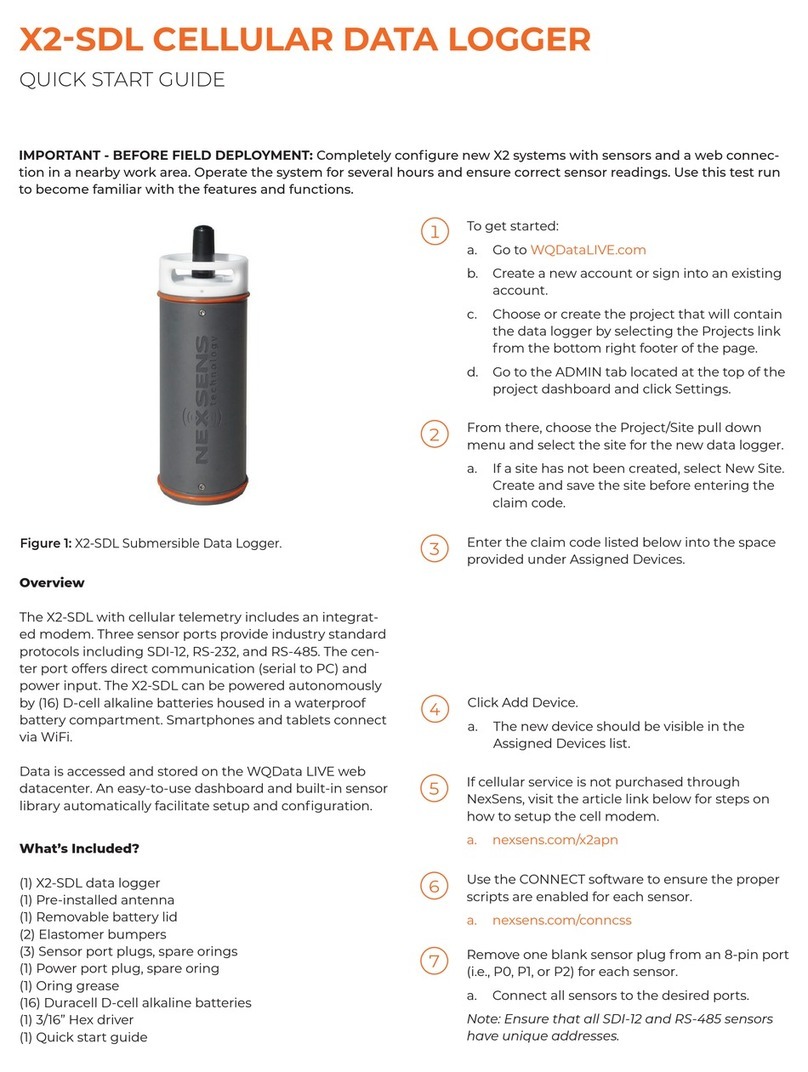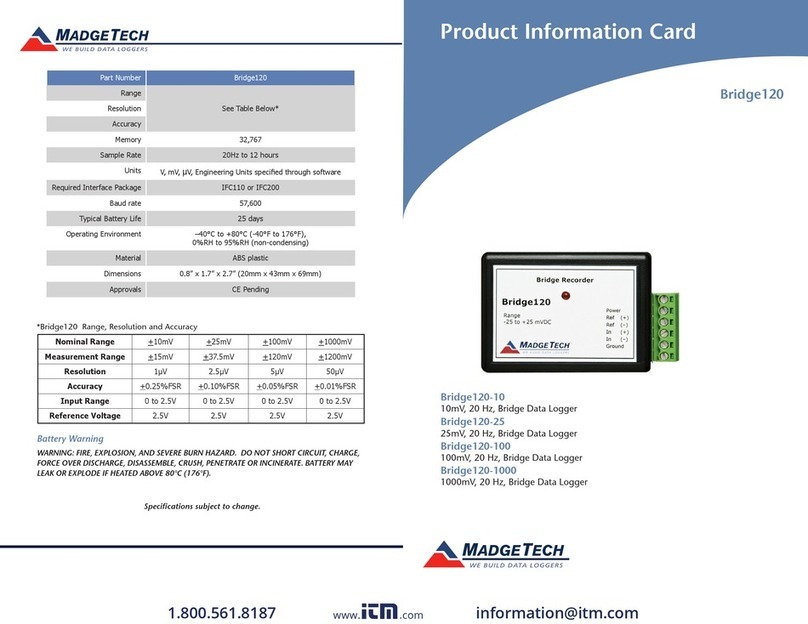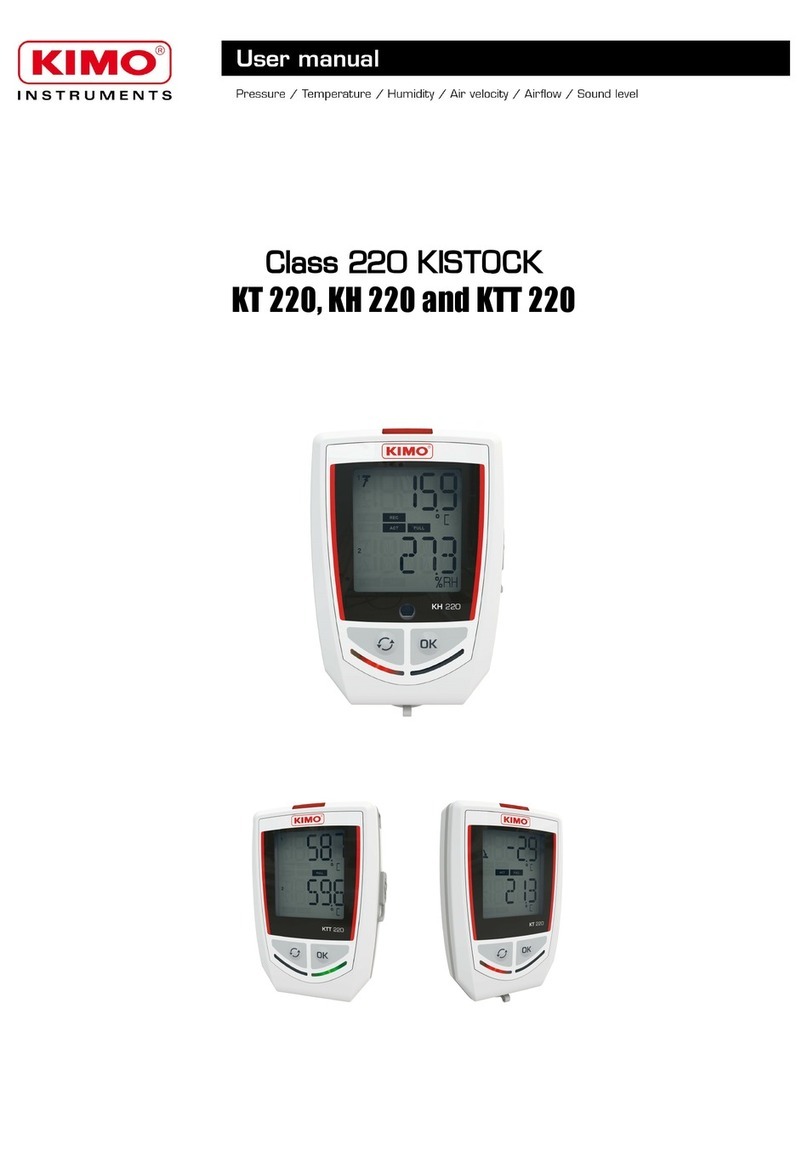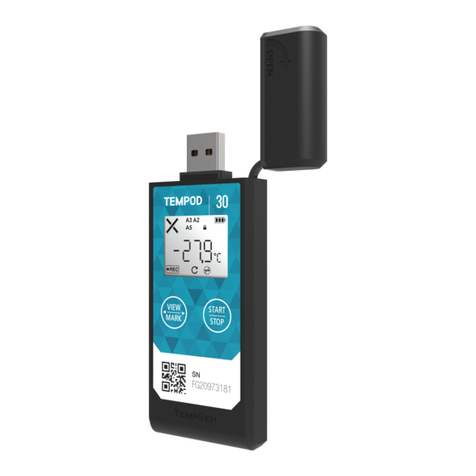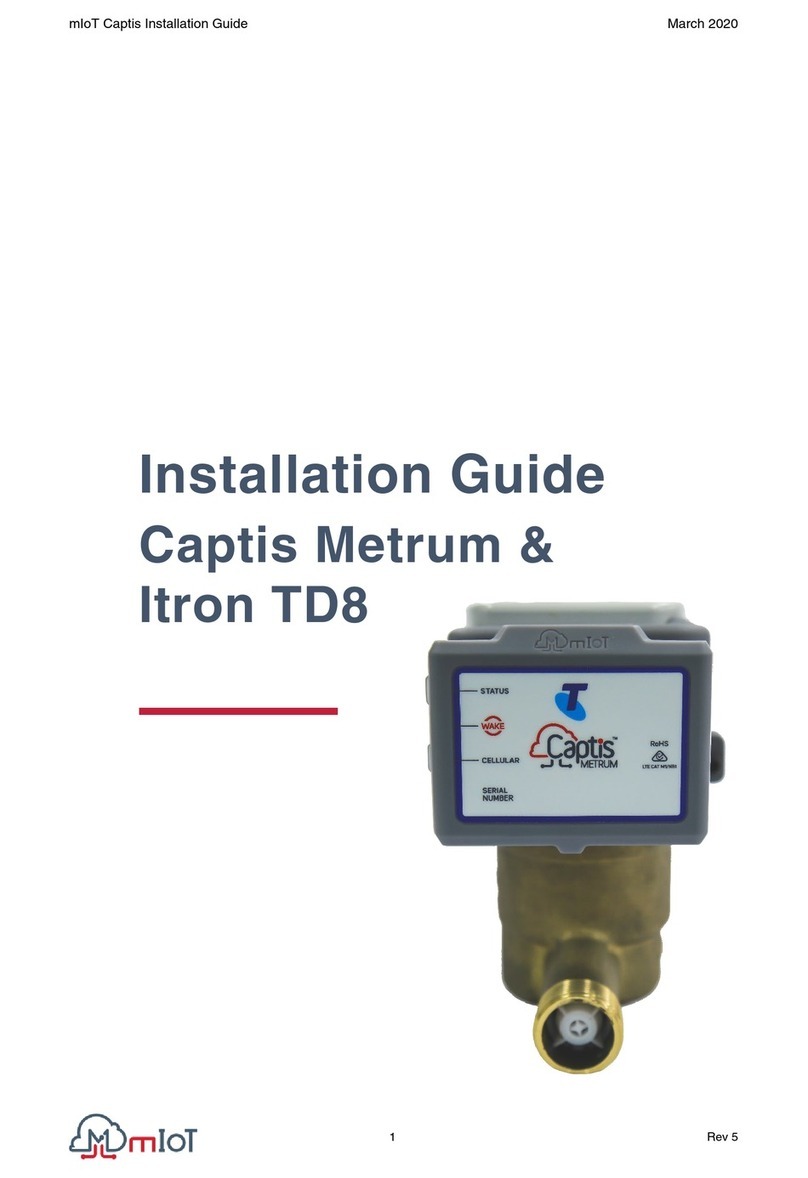Intab PC-logger 3150 Operating instructions

How to use
PC-logger 3150
Hardware
with
accessories
Interface-Teknik AB
Gjutarevägen 1
SE-443 61 STENKULLEN
Tel. +46(0)302-246 00
www.intab.se, [email protected]
Rev. E, January 2003

ii
MANUALS
of the
PC-Logger 3150 System:
-"How to Use PC-Logger 3150 " How to connect sensors and transducers
correctly
-"EasyView - manual" A tutorial guide to a user-friendly expert
data analysis program
-"Command Manual" Describes the ASCII strings (used by
software) that make the PC-Logger 3150
tick

iii
CONTENTS
MAIN UNIT......................................................................1
1 AN OVERVIEW ..............................................................................................................................1
1.1 G
ENERAL
I
NFORMATION
................................................................................................................1
1.2 O
N
-
LINE
R
ECORDINGS
....................................................................................................................2
1.3 O
FF
-
LINE
R
ECORDINGS
..................................................................................................................2
1.4 S
TORAGE
C
APACITY
.......................................................................................................................2
1.4.1 Storage capacity in Computer .............................................................................................3
1.4.2 Storage Capacity in the PC-Logger 3150............................................................................3
1.5 B
LOCK
D
IAGRAM
...........................................................................................................................4
1.6 D
ISPLAY AND
K
EYS
(
OPTION
).........................................................................................................5
1.6 P
OWER SUPPLY
...............................................................................................................................6
2 INPUTS/RANGES ...........................................................................................................................7
2.1 R
ANGES
:
V
OLTAGE AND
C
URRENT
.................................................................................................8
3 CONNECTIONS..............................................................................................................................9
3.1 P
OWER
...........................................................................................................................................9
3.2 C
OMPUTER
.....................................................................................................................................9
3.3 I
NPUTS
.........................................................................................................................................10
3.3.1 Differential Inputs..............................................................................................................11
3.3.2 Common Mode...................................................................................................................12
3.4 S
ENSOR
C
ONNECTION
E
XAMPLES
................................................................................................13
3.4.1 Connecting 20mA current loops ........................................................................................13
3.4.2 Connecting Voltage Signals...............................................................................................15
3.5 C
OMMON CONNECTION ERRORS
...................................................................................................16
4 STARTING RECORDINGS.........................................................................................................19
4.1 S
TART
T
RIG
..................................................................................................................................19
4.1.1 Start on key-stroke .............................................................................................................19
4.1.2 Start on digital input..........................................................................................................20
4.1.3 Start on Analog Level ........................................................................................................20
4.1.4 Digital and Level Start combined......................................................................................20
4.2 S
TOP
T
RIG
....................................................................................................................................20
4.2.1 Stop on key-stroke..............................................................................................................20
4.2.2 Stop on Digital Signal........................................................................................................21
4.2.3 Stop on Analog Level.........................................................................................................21
4.2.4 Stop when Memory Full.....................................................................................................21
4.3 T
RIG
W
INDOW
-
P
RE
/P
OST
T
RIG
R
ECORDING
...............................................................................22
4.4 Illustration: Start, Stop and Trig Sequences...........................................................................23
4.5 T
RIG
O
UTPUT
...............................................................................................................................24
5 MISCELLANEOUS.......................................................................................................................25
5.1 M
ASTER
R
ESET
............................................................................................................................25
5.2 C
ONTROL
P
ROGRAM
....................................................................................................................25
6 TECHNICAL SPECIFICATIONS...............................................................................................26
6.1 ANALOG
CIRCUITS.................................................................................................................26
6.2 A
UXILIARY VOLTAGE SOURCE
......................................................................................................27
6.3 T
RIGGER INPUT
/
OUTPUT
...............................................................................................................27
6.4 S
TORAGE MEMORY
(
OPTIONAL
)....................................................................................................28
6.5 C
OMPUTER COMMUNICATION
.......................................................................................................28
6.6 C
OMMANDS
..................................................................................................................................28

iv CONTENTS
6.7 P
OWER
.........................................................................................................................................29
6.8 M
ECHANICAL SPECIFICATIONS
.....................................................................................................29
OPTION: Digital I/O and Pulse Counters......................31
1 OVERVIEW...................................................................................................................................31
1.1 D
IGITAL
O
UTPUTS
........................................................................................................................31
1.2 D
IGITAL
I
NPUTS
...........................................................................................................................32
1.2.1 Opto isolated inputs........................................................................................................32
1.2.2 TTL-compatible inputs.................................................................................................... 32
2 COUNTERS ...................................................................................................................................33
2.1 R
ESET MODE
................................................................................................................................33
2.2 N
ORMAL MODE
............................................................................................................................33
3 CONNECTIONS............................................................................................................................34
3.1 D
IGITAL OUTPUTS
........................................................................................................................35
3.2 D
IGITAL INPUTS
...........................................................................................................................35
3.2.1 Opto Isolated ................................................................................................................... 36
3.2.2 TTL Compatible...............................................................................................................36
4 TECHNICAL DATA.....................................................................................................................37
4.1 D
IGITAL
O
UTPUTS
........................................................................................................................37
4.2 D
IGITAL
I
NPUTS
(@
25C
+/-10C) ................................................................................................37
4.2.1 Opto Isolated Inputs........................................................................................................37
4.2.2 TTL-compatible inputs....................................................................................................37
4.3 A
UXILIARY
P
OWER
......................................................................................................................38
4.3.1 for Opto-Couplers ...........................................................................................................38
4.3.2 for TTL-Inputs.................................................................................................................. 38
INDEX........................................................................................39

1
MAIN UNIT
1 AN OVERVIEW
MAIN UNIT
1 AN OVERVIEW
1.1 General Information
The PC-Logger 3150 is a very versatile addition to our line of Analog to
ASCII Converters. It will cover the medium measuring rate range: up to a 1000
times per second.
Input ranges are +/-10V; +/-1000mV; +/-100mV; +/-50mV; 20mA.
Pulse counters are available as an optional add-on.
An PC-Logger 3150 together with software and a personal computer
constitutes a powerful data acquisition system.
The main use is off-line when an internal memory (optional) of the PC-Logger
3150 stores data for later transferral to computer.
On-line use is also possible but is limited by the performance of connected
computer. Max speed has to be determined by experiment.
Main features are :
•8 analog inputs
•Programmable ranges on all inputs
•12 bit ADC
•Off-line memory data storage (optional)
•Trigger input and output
•Auxiliary voltage output
•Programmable sampling interval: 1ms to 1000ms
•Fully compatible with all INTAB logger software
The scope of this manual is to enable the user to correctly connect sensors and
transducers and use the PC-Logger 3150 off-line.
How the PC-Logger 3150 is handled using our software and a PC is explained
in the program manual and by the program itself by its user-friendly and self-
explanatory menus.
For best use and best results it is ABSOLUTELY essential that this
manual is studied in its entirety. Special emphasis should be put on
studying chapter 3 which describes how to connect transducers and other
signal sources.

2 INTAB Interface-Teknik AB
1.2 On-line Recordings
On-line measurements are performed with the PC-Logger 3150 connected to
the computer's RS-232 port. Measurements can in this mode be monitored in
real-timeon the computer's display. The user must however be aware of the
speed-limitations set by the computer: don't expect it to handle more than eight
channels five times a second. If you are the fortunate owner of a faster
computer with a fast disk-drive you can probably go faster.
The user him/herself has to determine the maximum speed on his/her particular
computer.
1.3 Off-line Recordings
Off-line recordings are possible with loggers equipped with (optional) data
memory.
Off-line measurements should be preceded by the transferral of measurement
parameters from the computer to the PC-Logger 3150.
These parameters contain, among others (see program manual), information
about measurement interval and what channels that are to be active. They are
effective until a new set of parameters are downloaded. The PC-Logger 3150
can, after downloading of the parameters, be disconnected from the computer
and started with the help of the keys next to the LCD (see section 1.5). After
all measurements are completed (see stop : section 4.2) the PC-Logger 3150 is
again connected to a computer for transferral of collected data (X-fer).
1.4 Storage Capacity
The number of measurements that can be stored by the PC-Logger 3150 and/or
computer is dependent on the size and type of memory used.
The longest possible duration of a recording is a function of the number of
channels that are active, sampling rate and the size of the storage medium.
A discussion of how the maximum length of a recording can be calculated
from known parameters follows below.
It is assumed that recordings are made using software supplied by INTAB.

3
MAIN UNIT
1 AN OVERVIEW
1.4.1 Storage capacity in Computer
Storage capacity in your computer can readily be calculated. The amount of
free space on the disk that will store your measurement data is the limiting
factor.
A 3½" disk will store more than 1,400,000 bytes. This is sufficient to store a
total of 700 000 values.
If we now consider a case where you sample and store 5 channels per second
the following formula applies:
Measuring time = 700 000/5 = 140 000 seconds or almost 40 hours. This time
is naturally multiplied by five if you only use one channel.
Another example: this storage space can be two measurement rounds, each of
two channels every other millisecond for a total duration of 700 seconds (or
nearly twelve minutes).
The formula you use is: interval*storage capacity divided by 2 and the number
of active channels : I*S/(2*C).
Apply this to a hard disk, and you will find that storage space will last a very
long time.
Remember that total storage time in a disk is the sum of all recordings. You
just have to allow for a header space of 16k bytes.
1.4.2 Storage Capacity in the PC-Logger 3150
Storage capacity in the PC-Logger 3150 itself is calculated almost in the same
way as it is calculated in the on-line case.
Three sizes of memory can be supplied: 64k, 64k+512k or 64k+1M.
Every value stored uses two bytes, so the formula in the previous section can
be used here too.
An example: having 64k memory, you want to measure four channels 10
times every second. The interval is 0.1 seconds.
The formula will then be: 0.1*64,000/(2*4)=800 seconds.
Note:
The internal memory of the PC-Logger 3150 will only store one recording at a
time. Starting a new recording will erase the previous one.
Recordings have to be transferred to your computer before loading new
parameters or starting new measurements.

4 INTAB Interface-Teknik AB
There is no limit to the number of times the same recording can be transferred
to the computer.
Measurement data will also not be lost if the internal batteries run down. A
back-up lithium battery will retain data for more than 10 years.
1.5 Block Diagram
This illustration shows a simplified block diagram of the PC-Logger 3150.
The expert notes that all amplification takes place before the multiplexer.

5
MAIN UNIT
1 AN OVERVIEW
1.6 Display and Keys (option)
The LCD (Liquid Crystal Display) with adjacent keys are supplied with all
PC-Logger 3150:s that are equipped with internal measurement data memory.
This display and key combination is indispensable when making off-line
recordings.
You indicate which function you want using the up/down arrows and then
confirm your choice with the OK-key.
The Multimeter is used to check transducer connections and function before
recording is started. You scroll up and down among the channels using the
up/down keys. Automatic scrolling is started with the key "hidden" under the
logo. A new channel is then shown every three seconds (try this feature by
pressing "PC-Logger 3100").
Record is selected when you intend to collect data. Verify your choice with
"OK". See illustration below and section 4 of this manual.
Starting a new recording will delete the previous one.
Don't forget to transfer data to the computer between recordings.
(*) See section 4 : TRIGGER.... for further information on starting and
stopping a recordings

6 INTAB Interface-Teknik AB
1.6 Power supply
The PC-Logger 3150 is normally powered by the supplied mains adaptor. It
has an output of 13.5V at a max of 500mA.
The PC-Logger 3150 is also fitted with internal rechargeable batteries. They
will give the user at least one hour of recording time without mains supply.
The batteries are trickle charged when the mains adaptor is connected. There is
no danger of overcharging the batteries, they should be left on charge to
prolong their life and keep them ready to use at all times.
Some applications require the PC-Logger 3150 to be powered by other
sources.
Use a cable fitted with a TA3F (Switchcraft) connector to connect to, for
example, a car battery.
Don't use sources supplying more than 16V as this is the maximum allowed.
The PC-Logger 3150 will "fall asleep", if it isn't powered by an outside source,
about two minutes after the last command or key-stroke has been entered. This
feature saves your rechargeable batteries for when they are needed.
Incoming serial (RS-232) commands or pressing the C-key will wake the PC-
Logger 3150.

7
MAIN UNIT
2 INPUTS/RANGES
2 INPUTS/RANGES
NOTE !
To get good results it is of utmost importance that all signals to be
measured are connected correctly.
Experience tells us that 95% of all problems (like noise, electrical
interference, measurement errors etc.) are the result of incorrect
connections and wiring.
A careful study of sections 2 and 3 is therefore highly recommended.
All analog inputs are differential and have no internal connection to signal
ground. The impedance between the positive and negative inputs to ground is
of the order of several megohms. They must therefore never be allowed to float
outside the specified common mode range, but must be referenced to ground in
some way.
The inputs are also balanced making them very unsusceptible to electrical
noise. Sensor wiring can be very long if a pair of twisted wires is used and the
ground reference is connected to the lowest potential of the signal source via a
separate wire.

8 INTAB Interface-Teknik AB
2.1 Ranges: Voltage and Current
Each programmable (option) range or preset range has a resolution of at least
+/-1800 divisions.
Translated into measured units this can be illustrated like this:
RANGE RESOLUTION ACCURACY
+/-10V
+/-1000mV
+/-100mV
+/-50mV
+/-20mA
5.5mV
0.55mV
0.055mV
30µV
11µA
0.12% of FSR
0.12% of FSR
0.12% of FSR
0.12% of FSR
0.12% of FSR
Each channel has an internal 51Ωshunt that is used to measure current. It is
connected into the input circuitry by putting the small DIP-switch in position
"current".

9
MAIN UNIT
3 CONNECTIONS
3 CONNECTIONS
3.1 Power
Power is applied through a TA3F (Switchcraft) female connector connected as
follows :
Pin 1 :
Pin 2 :
Pin 3 :
13 - 16VDC
0V
18 - 24VDC
N.B. Connecting power through pin 3 is an alternative to pin 1 !
3.2 Computer
PC-Logger 3150 connects to a serial port of the computer using the supplied
spiral cable.
The 15 pin D-Sub connector has the following pinouts:
pin 2: Tx
pin 3: Rx
pin 5: CTS
pin 6: DTR
pin 7: GND
Leave the rest of the pins unconnected!
Typical PC-Logger 3150 to computer cables:

10 INTAB Interface-Teknik AB
3.3 Inputs
Transducers and sensors connect to the detachable screw terminals.
Here is an illustration of how the screw terminals are placed.
These are analog channel inputs.
Behind each channel input terminal there is a pair of Dip-
switches.
One (Volt/Current) connects the shunt resistor into the
input circuitry for current measurements (0 - 20mA).
The other (Diff/ Gnd) shorts the negative input to signal
(or reference) ground for single ended measurements.
This terminal (Gnd) is logger signal ground. All signals
must in some way be referenced to this point.
"+5V" is an auxiliary voltage for the Trig input (T-in).
"T-in" is a trigger input to start or stop recordings.
"G" is the signal return (ground) for trig-signals.
"T-out" is an output reflecting trig status.
"V-Out" is an auxiliary voltage for sensors or x-ducers.
Its voltage is adjustable between 2V and 10V by a
potentiometer.
These terminals are found under the lid of the logger. They are detachable.
Use the 16-hole bracket as strain-relief for transducer cables. You can use a
tie-wrap or simply thread the wire trough two holes.
NOTE!
These terminals are accessible also in those loggers that are equipped with an
optional jack panel. The jack panel must be regarded as just an extension box
and does NOT make familiarisation with the terminal area unnecessary.
The user still has to determine how the dip-switches are to be programmed.

11
MAIN UNIT
3 CONNECTIONS
3.3.1 Differential Inputs
There are a two basic requisites that have to be fulfilled when connecting
signals and/or sensors and transducers :
1 - No signal must be left floating with respect to logger signal ground.
2 - System grounds must be connected so that no ground loops are created.
Use a one-point grounding scheme!
The following sections will help in understanding how this can be achieved.
Let us first take a look at a block diagram of the inputs.
Differential channels (inputs) can be considered to be two different inputs:
•the - input measures the voltage between the GND and
-
•the + input measures the voltage between the GND and +
The difference between these two voltages is then "calculated" internally.
From the above it must be obvious that just applying a voltage between - and +
cannot possibly work! The amplifier must see signals referenced to GND.
(GND, by the way, is an internal "signal ground" or reference that has nothing
in common with mains protective ground or any other ground that may be
lying around.)
If you have problems in understanding this, it is a good idea to tie the
-
input to
GND by putting the "Diff/Gnd" switch in position "Gnd". The result will be
that the channel will measure the voltage at the + input and then subtract the
voltage at the - input (which is zero volts) and present the correct value.
Just be sure that all your minuses have the same potential so that no
smoke signals are generated.

12 INTAB Interface-Teknik AB
N.B.
In all work connecting signals to the logger you have to take the following
points into account :
•Analog ground is common to all channels.
•Analog ground is internally connected to RS-232 signal return (D-sub
pin 7).
•Analog ground is internally connected to power input return ( pin 2).
•Analog ground is internally connected to trig input and output signal
return ("G")
•Analog ground is internally connected to negative V-out.
3.3.2 Common Mode
To maintain accuracy in your measurements you have to take the common
mode range into account. The common mode range is 10V.
This is another way of looking at or taking advantage of the "differentiality" of
the inputs.
The impedances between "Gnd" and positive and "Gnd" and negative inputs
are very high. This means that unless they in some way are connected, the
inputs may float electrically, way beyond the allowed limit.
The inputs will not be damaged by voltages above this as long as they are
within 30V off signal ground.
The following sections of this manual will provide some examples of how
transducers can be connected.

13
MAIN UNIT
3 CONNECTIONS
3.4 Sensor Connection Examples
Transducers can supply signals of differing types. They are usually "single
ended" or "differential" (ratiometric). Below are some examples of how they
can be connected. Note that combinations are always possible.
It is also always good practise to plan connections and to make a schematic
diagram before actually doing them.
3.4.1 Connecting 20mA current loops
Currents are usually process type signals: 0-20mA or 4-20mA.
These loops can be connected in more ways than one.
It cannot be stressed enough that it is necessary to have a diagram of the
system from which these signals emanate in order to connect multiple
signals correctly.
Remember that the 51Ωshunt resistor has to be connected to the input
circuitry by putting the Dip-switch in position "current". See illustrations
below.
1) Connecting current loops with common grounding :
One connection to
the common ground
potential is enough.
Two would have
created a ground
loop that may cause
problems in the
form of electrical
interference.
"Other instruments" may also be connected in the current return path if it is
absolutely certain that the total voltage drop across them is well within max
common mode range.

14 INTAB Interface-Teknik AB
2) Connecting floating (ungrounded) current loops
All signals have to
be referenced to
"Gnd".
They may otherwise
drift outside the
common mode
range.
3) Connecting two-wire mA transmitters using power from V-out.
The auxiliary Voltage output
(V-out) can power 20mA
transmitters.
Make sure that the voltage is
sufficient for your x-mitter.
4) Connecting two-wire mA transmitters powered by external source.
Transmitters that require
higher voltages have to be
powered by an external
source.
Don't forget to put the dip-
switch in position "Gnd"
unless this source has some
other connection to logger
ground.

15
MAIN UNIT
3 CONNECTIONS
3.4.2 Connecting Voltage Signals
Voltage signals can be connected in two basic ways. Which one to use depends
on whether the signal is "floating" or not.
Combinations of the two methods are of course possible!
Differential or ratiometric transducers may also be directly connected.
1) Connecting signals with common grounding
Note that only one of the
Diff/Gnd switches is in
position "Gnd".
This will establish a
good reference potential
for both channels.
2) Connecting isolated or "floating" signals.
Each floating signal has
to be individually
grounded to logger
"Gnd".
3) Differential or Ratiometric transducers
This illustration shows
how a bridge type
transducer (load cells,
pressure sensors etc.)
should be connected.
The "V-out" is used as
excitation voltage.

16 INTAB Interface-Teknik AB
3.5 Common connection errors
1) Ground loops:
Instrument with two Single Ended Outputs
Two apparently separate outputs from an instrument are each connected to a
channel. Both channels have the negative input shorted to ground via the
"Diff/Gnd"-switches.
Measured values may be either unstable or inaccurate.
Solution: break the ground loop by putting one of the switches in the "Diff"
position.
2) Floating signal : no connection to system ground
A signal equivalent to a common flashlight battery is connected to + and - of
one of the channels. Readings are unstable.
Solution: give this signal a proper ground reference by shorting the negative
input to logger ground by placing the Dip-switch in the "Gnd" position.
Table of contents
Other Intab Data Logger manuals
